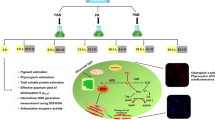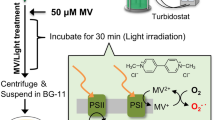Abstract
The intracellular redox and the circadian clock in photosynthetic organisms are two major regulators globally affecting various biological functions. Both of the global control systems have evolved as systems to adapt to regularly or irregularly changing light environments. Here, we report that the two global regulators mutually interact in cyanobacterium Synechococcus elongatus PCC7942, a model photosynthetic organism whose clock molecular mechanism is well known. Electrochemical assay using a transmembrane electron mediator revealed that intracellular redox of S. elongatus PCC7942 cell exhibited circadian rhythms under constant light conditions. The redox rhythm disappeared when transcription/translation of clock genes is defunctionalized, indicating that the transcription/translation controlled by a core KaiABC oscillator generates the circadian redox rhythm. Importantly, the amplitude of the redox rhythm at a constant light condition was large enough to affect the KaiABC oscillator. The findings indicated that the intracellular redox state is actively controlled to change in a 24-h cycle under constant light conditions by the circadian clock system.






Similar content being viewed by others
References
Borisova-Mubarakshina MM, Vetoshkina DV, Ivanov BN (2019) Antioxidant and signaling functions of the plastoquinone pool in higher plants. Physiol Plant 166:181–198
Dodd AN, Kusakina J, Hall A, Gould PD, Hanaoka M (2014) The circadian regulation of photosynthesis. Photosynth Res 119:181–190
Edgar RS et al (2012) Peroxiredoxins are conserved markers of circadian rhythms. Nature 485:459–464
Foyer CH, Noctor G (2009) Redox regulation in photosynthetic organisms: signaling, adaptation, and practical implications. Antioxid Redox Signal 11:861–905
Gutu A, O’Shea EK (2013) Two antagonistic clock-regulated histidine kinases time the activation of circadian gene expression. Mol Cell 50:288–294
Ishiura M, Kutsuna S, Aoki S, Iwasaki H, Andersson CR, Tanabe A, Golden SS, Johnson CH, Kondo T (1998) Expression of a gene cluster kaiABC as a circadian feedback process in Cyanobacteria. Science 281:1519–1523
Ito H, Mutsuda M, Murayama Y, Tomita J, Hosokawa N, Terauchi K, Sugita C, Sugita M, Kondo T, Iwasaki H (2009) Cyanobacterial daily life with Kai-based circadian and diurnal genome-wide transcriptional control in Synechococcus elongatus. Proc Natl Acad Sci USA 106:14168–14173
Ivleva NB, Bramlett MR, Lindahl PA, Golden SS (2005) LdpA: a component of the circadian clock senses redox state of the cell. EMBO J 24:1202–1210
Ivleva NB, Gao T, LiWang AC, Golden SS (2006) Quinone sensing by the circadian input kinase of the cyanobacterial circadian clock. Proc Natl Acad Sci USA 103:17468–17473
Iwasaki H, Williams SB, Kitayama Y, Ishiura M, Golden SS, Kondo T (2000) A KaiC-interacting sensory histidine kinase, SasA, necessary to sustain robust circadian oscillation in cyanobacteria. Cell 101:223–233
Johnson CH, Zhao C, Xu Y, Mori T (2017) Timing the day: what makes bacterial clocks tick? Nat Rev Microbiol 15:232–242
Katayama M, Kondo T, Xiong J, Golden SS (2003) ldpA encodes an iron-sulfur protein involved in light-dependent modulation of the circadian period in the cyanobacterium Synechococcus elongatus PCC7942. J Bacteriol 185:1415–1422
Kim YI, Vinyard DJ, Ananyev GM, Dismukes GC, Golden SS (2012) Oxidized quinones signal onset of darkness directly to the cyanobacterial circadian oscillator. Proc Natl Acad Sci USA 109:17765–17769
Lai AG, Doherty CJ, Mueller-Roeber B, Kay SA, Schippers JH, Dijkwel PP (2012) CIRCADIAN CLOCK-ASSOCIATED 1 regulates ROS homeostasis and oxidative stress responses. Proc Natl Acad Sci USA 109:17129–17134
Lu Y, Nishio K, Matsuda S, Toshima Y, Ito H, Konno T, Ishihara K, Kato S, Hashimoto K, Nakanishi S (2014) Regulation of the cyanobacterial circadian clock by electrochemically controlled extracellular electron transfer. Angew Chem Int Ed 53:2208–2211
Markson JS, Piechura JR, Puszynska AM, O’Shea EK (2013) Circadian control of global gene expression by the cyanobacterial master regulator RpaA. Cell 155:1396–1408
Mutsuda M, Michel KP, Zhang X, Montgomery BL, Golden SS (2003) Biochemical properties of CikA, an unusual phytochrome-like histidine protein kinase that resets the circadian clock in Synechococcus elongatus PCC 7942. J Biol Chem 278:19102–19110
Nakahata Y, Sahar S, Astarita G, Kaluzova M, Sassone-Corsi P (2009) Circadian control of the NAD + salvage pathway by CLOCK-SIRT1. Science 324:654–657
Nakajima M, Imai K, Ito H, Nishiwaki T, Murayama Y, Iwasaki H, Oyama T, Kondo T (2005) Reconstitution of circadian oscillation of cyanobacterial KaiC phosphorylation in vitro. Science 308:414–415
Nishio K, Pornpitra T, Izawa S, Nishiwaki-ohkawa T, Kato S, Hashimoto K, Nakanishi S (2015) Electrochemical detection of circadian redox rhythm in cyanobacterial cells via extracellular electron transfer. Plant Cell Physiol 56:1053–1058
Noordally ZB, Ishii K, Atkins KA, Wetherill SJ, Kusakina J, Walton EJ, Kato M, Azuma M, Tanaka K, Hanaoka M, Dodd AN (2013) Circadian control of chloroplast transcription by a nuclear-encoded timing signal. Science 339:1316–1319
Ramsey KM, Yoshino J, Brace CS, Abrassart D, Kobayashi Y, Marcheva B, Hong HK, Chong JL, Buhr ED, Lee C, Takahashi JS, Imai S, Bass J (2009) Circadian clock feedback cycle through NAMPT-mediated NAD + biosynthesis. Science 324:514–651
Rutter J, Reick M, Wu LC, McKnight SL (2001) Regulation of clock and NPAS2 DNA binding by the redox state of NAD cofactors. Science 293:510–514
Schmitz O, Katayama M, Williams SB, Kondo T, Golden SS (2000) CikA, a Bacteriophytochrome that resets the cyanobacterial circadian clock. Science 289:765–768
Swan JA, Golden SS, LiWang A, Partch CL (2018) Structure, function, and mechanism of the core circadian clock in cyanobacteria. J Biol Chem 293:5026–5034
Takai N, Nakajima M, Oyama T, Kito R, Sugita C, Sugita M, Kondo T, Iwasaki H (2006) A KaiC-associating SasA-RpaA two-component regulatory system as a major circadian timing mediator in cyanobacteria. Proc Natl Acad Sci USA 103:12109–12114
Tanaka K, Kaneko M, Ishikawa M, Kato S, Ito H, Kamachi T, Kamiya K, Nakanishi S (2017) Specific interaction between redox phospholipid polymers and plastoquinone in photosynthetic electron transport. ChemPhysChem 18:878–881
Tomita J, Nakajima M, Kondo T, Iwasaki H (2005) No transcription-translation feedback in circadian rhythm of KaiC phosphorylation. Science 307:251–254
Yen U, Huang T, Yen T (2004) Observation of the circadian photosynthetic rhythm in cyanobacteria with a dissolved-oxygen meter. Plant Sci 166:949–952
Acknowledgements
We thank Prof. H. Iwasaki (Waseda University) for kindly providing the mutants used in this work. This work was partially supported by the Advanced Low Carbon Technology Research and Development Program (JPMJAL1402) of the Japan Science and Technology Agency (JST) and JSPS KAKENHI Grant No. 18J20176.
Author information
Authors and Affiliations
Corresponding author
Ethics declarations
Conflict of interest
The authors declare that they have no conflict of interest.
Additional information
Publisher's Note
Springer Nature remains neutral with regard to jurisdictional claims in published maps and institutional affiliations.
Electronic supplementary material
Below is the link to the electronic supplementary material.
Rights and permissions
About this article
Cite this article
Tanaka, K., Ishikawa, M., Kaneko, M. et al. The endogenous redox rhythm is controlled by a central circadian oscillator in cyanobacterium Synechococcus elongatus PCC7942. Photosynth Res 142, 203–210 (2019). https://doi.org/10.1007/s11120-019-00667-0
Received:
Accepted:
Published:
Issue Date:
DOI: https://doi.org/10.1007/s11120-019-00667-0




